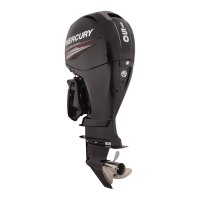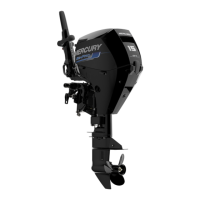BATTERY CHARGING AND STARTING SYSTEMS
90-826883R2 JUNE 1998 Page 2B-5
Hydrometermeasurespercentageofsulfuricacidinbatteryelectrolyteintermsofspecific
gravity.Asabatterydropsfromachargedtoadischargedcondition,acidleavesthesolu-
tion and chemically combines with the plates, causing a decrease in specific gravity of
electrolyte. An indication of concentration of electrolyte is obtained with a hydrometer.
When using a hydrometer, observe the following points:
1. Hydrometer must be clean (inside and out) to insure an accurate reading.
2. Never take hydrometer readings immediately after water has been added. Water
mustbe thoroughlymixed withelectrolyte bycharging forat least15 minutesat arate
high enough to cause vigorous gassing.
3. If hydrometer has built-inthermometer, draw liquidinseveral times toensure correct
temperature before taking reading.
4. Holdhydrometerverticallyanddrawinjustenoughliquidfrombatterycellsothatfloat
is free-floating. Hold hydrometer at eye level so that float is vertical and free of outer
tube, then take reading at surface of liquid. Disregard curvature where liquid rises
against float stem due to capillary action.
5. Avoid dropping electrolyte on boat or clothing, as it is extremely corrosive. Wash off
immediately with baking soda solution.
Specificgravity ofelectrolytevaries notonlywith percentageofacid inliquidbut alsowith
temperature.As temperature drops, electrolyte contracts, so that specific gravity in-
creases.Unlessthesevariationsinspecificgravityaretakenintoaccount,specificgravity
obtained by hydrometer maynot give a trueindication ofconcentration ofacid inelectro-
lyte.
A fully charged battery will have a specific gravity reading of approximately 1.270 at an
electrolyte temperature of 80° F (27°C). Ifelectrolyte temperature isabove or below80°
F, additions or subtractions must be made in order to obtain a hydrometer reading cor-
rectedto80°Fstandard.Forevery10°F(3.3°C)above80°F,add4specificgravitypoints
(.004) to hydrometer reading. Example: A hydrometer reading of 1.260at 110° F (43° C)
would be 1.272 corrected to 80° F, indicating a fully charged battery.
Forevery10°below80°F,subtract4points(.004)fromthereading.Example:Ahydrome-
terreadingof1.272at0°F(-18°C)wouldbe1.240correctedto80°F,indicatingapartially
charged battery.
SPECIFIC GRAVITY CELL COMPARISON TEST
This test may be used when an instrumental tester is not available. To perform this test,
measure specific gravity of each cell, regardless of state of charge, and interpret results
as follows: Ifspecific gravity readings show a difference between highest and lowestcell
of .050 (50 points) or more, battery is defective and should be replaced.
Electrolyte Level
Check electrolyte level in battery regularly. A battery in use in hot weather should be
checked more frequently becauseof more rapid loss of water.Ifelectrolytelevel is found
to be low, thendistilled water shouldbe added toeach celluntil liquidlevel risesapproxi-
mately 3/16” (4.8mm) over plate. DO NOT OVERFILL, because this will cause loss of
electrolyte and result in poor performance, short life and excessive corrosion.
CAUTION
During service, only distilled water should be added to the battery, not electro-
lyte.

